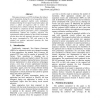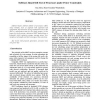70 search results - page 1 / 14 » A Test Pattern Generation Methodology for Low-Power Consumpt... |
VTS
1998
IEEE
13 years 9 months ago
1998
IEEE
This paper proposes an ATPG technique that reduces power dissipation during the test of sequential circuits. The proposed approach exploits some redundancy introduced during the t...
EVOW
1999
Springer
13 years 9 months ago
1999
Springer
A technique is proposed to reduce the peak power consumption of sequential circuits during test pattern application. High-speed computation intensive VLSI systems, as telecommunica...
ATS
2004
IEEE
13 years 9 months ago
2004
IEEE
In this paper, we propose a low-power testing methodology for the scan-based BIST. A smoother is included in the test pattern generator (TPG) to reduce average power consumption d...
ASPDAC
2009
ACM
13 years 11 months ago
2009
ACM
Low power circuits have become a necessary part in modern designs. Retention flip-flop is one of the most important components in low power designs. Conventional test methodologie...
DATE
2006
IEEE
13 years 11 months ago
2006
IEEE
Software-based self-test (SBST) of processors offers many benefits, such as dispense with expensive test equipments, test execution during maintenance and in the field or initiali...


